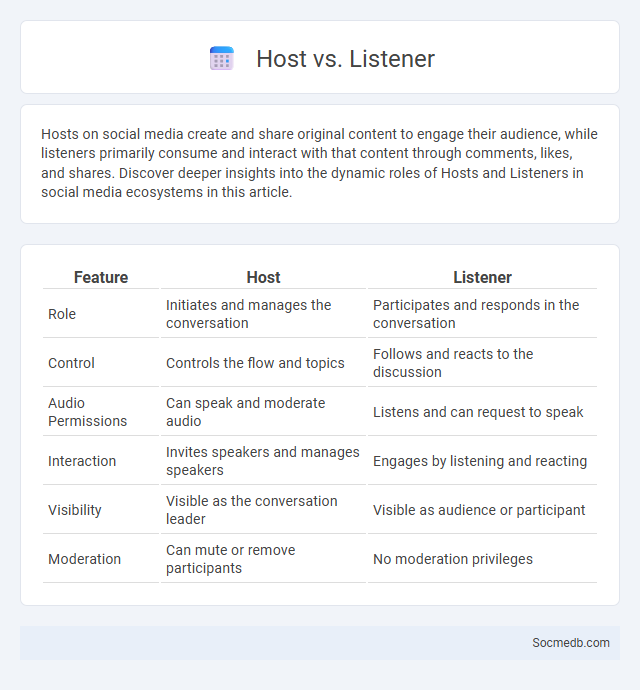
Photo illustration: Host vs Listener
Hosts on social media create and share original content to engage their audience, while listeners primarily consume and interact with that content through comments, likes, and shares. Discover deeper insights into the dynamic roles of Hosts and Listeners in social media ecosystems in this article.
Table of Comparison
| Feature | Host | Listener |
|---|---|---|
| Role | Initiates and manages the conversation | Participates and responds in the conversation |
| Control | Controls the flow and topics | Follows and reacts to the discussion |
| Audio Permissions | Can speak and moderate audio | Listens and can request to speak |
| Interaction | Invites speakers and manages speakers | Engages by listening and reacting |
| Visibility | Visible as the conversation leader | Visible as audience or participant |
| Moderation | Can mute or remove participants | No moderation privileges |
Introduction to Twitter Spaces Hosting Roles
Twitter Spaces hosting roles define your ability to create and manage live audio conversations on the platform, enhancing real-time engagement with your audience. Hosts can invite speakers, control the discussion flow, and moderate content to maintain a positive environment. Mastering these roles empowers your social media strategy, driving deeper connections and interactive experiences on Twitter.
Defining the Host in Twitter Spaces
Defining the host in Twitter Spaces involves identifying the user responsible for managing the live audio session, moderating speakers, and controlling the flow of conversation. The host has exclusive privileges to invite co-hosts, mute participants, and end the Space, ensuring a well-organized and engaging experience. Your role as the host is crucial for setting the tone and maintaining order during Twitter Spaces events.
Understanding the Listener Role
Understanding the listener role on social media is crucial for effective communication and engagement. Listeners analyze content, interpret messages, and provide feedback that shapes community dynamics and brand perception. Recognizing listening behaviors helps brands tailor content strategies to boost interaction and build trust with their audience.
What is a Spaces Co-host?
A Spaces Co-host on social media platforms like Twitter is a participant who helps manage the live audio conversation alongside the host. Your role as a Spaces Co-host includes moderating discussions, inviting speakers, and maintaining a respectful and engaging environment for all listeners. This collaboration enhances the overall experience and ensures smooth communication during the session.
Key Responsibilities of a Host
A social media host manages live broadcasts, engaging with the audience through comments and questions to maintain interactive communication. They coordinate content flow, ensuring timely presentation of segments while adapting to real-time feedback. Monitoring analytics during streams helps optimize engagement strategies for future broadcasts.
Capabilities Exclusive to Co-hosts
Co-hosts on social media platforms have exclusive capabilities such as managing live sessions, moderating comments, and sharing content directly with the audience, enhancing interactive engagement. These features allow you to collaboratively control the narrative, boost follower interaction, and maintain a smooth, professional broadcast experience. Leveraging co-host privileges can significantly increase content reach and audience connection.
Listener Participation and Limitations
Listener participation on social media platforms boosts engagement by encouraging comments, shares, and real-time interactions through polls, live streams, and Q&A sessions. Your ability to connect with audiences is often limited by algorithm restrictions, platform policies, and potential misinformation, which can reduce content visibility and impact. Understanding these limitations helps optimize strategies for better community involvement and meaningful exchanges.
Comparison: Host vs Listener vs Co-host
Choosing between host, listener, or co-host roles on social media platforms influences your level of engagement and content control. As a host, you have full authority to shape discussions and direct the flow, while a co-host shares responsibilities and enhances collaboration, often leading to richer interactions. Your experience as a listener prioritizes content consumption and interaction without moderating duties, ideal for absorbing information and participating passively.
How to Become a Host, Listener, or Co-host
Becoming a host, listener, or co-host on social media requires understanding platform-specific tools and audience engagement strategies. You can start by selecting a niche, building your profile, and actively participating in live sessions or podcast communities. Consistently creating valuable content and interacting with your audience will increase your visibility and opportunities to collaborate as a co-host or become a recognized listener.
Choosing the Right Role for Your Twitter Spaces Event
Selecting the appropriate role for your Twitter Spaces event ensures smooth moderation and enhances audience engagement. Assigning roles such as host, speaker, and listener clearly defines responsibilities, helping to maintain order and foster meaningful discussions. Your thoughtful role choices directly impact the overall quality and success of the live audio experience.
 socmedb.com
socmedb.com